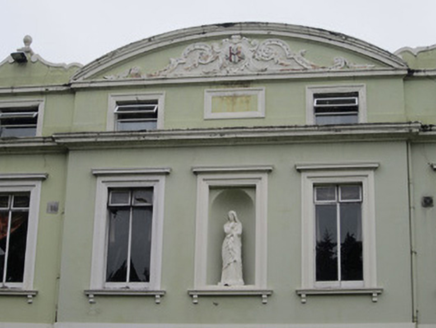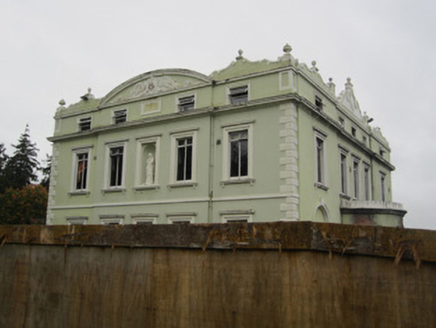Survey Data
Reg No
41308045
Rating
Regional
Categories of Special Interest
Architectural, Historical
Previous Name
Blayney Castle originally Castle Blayney
Original Use
Country house
Historical Use
Hospital/infirmary
Date
1795 - 1870
Coordinates
283077, 319586
Date Recorded
01/10/2011
Date Updated
--/--/--
Description
Five-bay three-storey country house with basement, built 1799, to designs by architect Robert Woodgate, having central bays to front elevation with single-storey entrance porch. Five-bay side elevations have slightly recessed central bays, with single-storey bow to east, lake, elevation, and slightly projecting middle bays to south, garden, elevation. Roof concealed by crested rendered parapets with urns and finials having scrolled plaster decorated pediment to lake elevation and segmental pediment to garden, added in Victorian era. Cast-iron downpipes drain parapet gutter, located between ends bays of elevations. Moulded cornice between parapet and top floor, heavier moulded cornice between top and first floors, and simple string course between first and ground floors. Flat-roofed bow to lake elevation has render parapet and dentillated cornice. Walls painted smooth rendered with rusticated render quoins. Square headed window openings throughout, except for end bays of ground floor of garden elevation which are round-headed with keystones, all with moulded architraves and having cornices to lower floors. Replacement uPVC frames to many openings, and boarded up elsewhere, with moulded stone sills to first floor, held on scrolled corbels. Middle opening to first floor of garden elevation has round-headed niche with plaster statue, and top floor has blank rectangular panel. Porch has flat roof with decorative cast-iron brattishing to parapet. Round-headed door and window openings have imposts and moulded archivolts, doorway has large spoked fanlight and replaced double-leaf timber door, flanked by pilasters. Low balustrade to basement area with turned balusters and moulded coping to each side of porch. Single-storey late twentieth-century pitched roof extension to recessed central three bays of rear elevation obscured by timber hoarding. Three-centred arch vehicular access opening with ashlar sandstone block-and-start dressings to west of house and accessed via roadway connected with former stable block to south-west. House stands facing lawns stretching as far as Lough Muckno shores to north and east, with golf course on former parkland to south-east of house.
Appraisal
Known also as Blayney Castle after the plantation castle nearby (from which the town gets its name), Hope Castle was built by Andrew Thomas, eleventh Lord Blayney who ran the associated estate from 1784 to his death in 1832. Originally a five-bay three-storey Georgian block, the house received many embellishments during the Victorian era, including scrolled cresting on the roof parapets and at one stage an ornamental cast-iron and glass porch canopy. The present country house is notable for the different treatments of the principal elevations, enhanced by the various recesses and projections, and embellished by the wide variety of render details. Its associated walled garden, stable block, entrance gates, gate lodges and other features make this one of the most intact of Monaghan's demesnes. The subsequent history of the house and demesne is particularly varied, having been sold in 1853 to the Hope family after whom the famous Hope Diamond is named, later occupied by Queen Victoria's son, the Duke of Connaught. The British Army had a barracks there later, it functioned as Monaghan County Hospital from 1932-7, then as a Franciscan convent from 1943–74. A period of dereliction followed until it was taken over the local council in the 1980s. Nineteenth-century additions to the garden and main fronts were demolished during works at this time. One interesting internal feature – a Soanesque top-lit upper stair landing was destroyed during the phase of dereliction. Recent use as a hotel and leisure complex were short-lived and the site has remained derelict since an arson attack in 2010.





